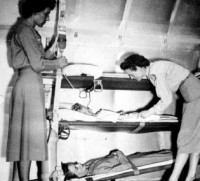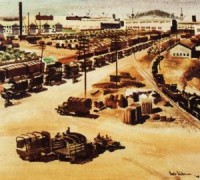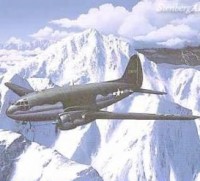WAR IS OVER - THE HOMEWARD BOUND TRAFFIC - AIR EVACUATION
2)REDEPLOYMENT OF AIRCRAFT
Operating under a basic war plan which provided for disposing of the European adversary before turning to direct a final blow at the enemy on the other side of the globe, the American high command was obliged to plan far in advance for the day when men and weapons might be transferred from one theater of war to the other. Each echelon of command in Washington developed such plans for redeployment. Those framed at ATC headquarters were begun well over a year before V-E Day.
In September 1944 the Chief of the Air Staff outlined a general division of responsibility in connection with such redeployment between the several assistant chiefs of the Air Staff, other Air Force agencies, and the Air Transport Command. Emphasis thus far was placed upon the flight of aircraft and their crews from the European or Mediterranean theaters to the Pacific. Such a movement would provide reinforcements needed for victory against Japan, would scale down U.S. air forces in England and on the Continent to essential garrison units, and would give veteran aircrews a welcome trip home during the move from Europe to the Far East.
During the summer of 1944, ATC endeavored to gain control of, and improve the facilities of, necessary staging bases in California in anticipation of the increased flow of ferried aircraft across the Pacific. Other aspects of the problem were considered, too, and by September ATC headquarters was ready to distribute to the commanders of the several divisions concerned a top-secret plan for the movement from the European and Mediterranean theaters to the United States. The divisions, in turn, made detailed plans for their share in this program.
The project as a whole was for some reason still classified as top secret on 30 April 1945, but, when ATC headquarters on 5 May 1945 issued its revised instructions to the field, the classification had been reduced to "restricted."The Air Transport Command's task, designated WHITE PROJECT, involved the return to America of some 2,825 heavy bombers from the European theater, and 1,240 from the Mediterranean theater. These, with varying numbers of passengers, were to be flown to the United States by full combat crews.
All three major Atlantic routes were to be utilized. One version of the plan called for fifty or sixty aircraft a day to fly the North Atlantic route from Valley in Wales through Iceland; twelve a day from the European theater and from five to twenty from MTO were to follow the Central Atlantic route through the Azores. Some twenty-five bombers a day were to fly home by the lengthy South Atlantic route. Meanwhile in April the eastward flow of aircraft for the European war ground to a halt.
First to be held up were all four-engine bombers (B-24's and B-17's) not equipped with radar; then, all heavy bombers; and, finally, on 28 April 1945, other types of aircraft. This allowed almost a month's lull in which to prepare for the reverse ferrying movement. WHITE PROJECT got under way on 20 May 1945, when seventy-one bombers took off from Valley and a smaller number from Marrakech, Morocco, for the long-awaited homeward trip.Originally planned to last only through August, the WHITE PROJECT was extended to 31 October 1945.
The westward flow of heavy bombers had hardly started when ATC received instructions to assume comparable responsibility for the homeward flight of an estimated 1,000 twin-engine bombers and transports from ETO and MTO. It was taken for granted that crews which had flown a given type of aircraft in combat or in troop-carrier service should fly it home. At the same time there was no disposition to challenge the established principle that aircraft and crews en route east or west should be subject to the control of ATC, one of whose specialties was the direction of the overwater ferrying of aircraft.
There were difficulties, of course. ATC officers in the field had to co-ordinate WHITE PROJECT flights not only with the regular ATC transport flights in each direction and with some ferrying of new transports eastward to the India-China Division but also with the parallel and enormous GREEN PROJECT for the return of personnel to the United States.
When it was decided to make Bradley Field at Windsor Locks, Connecticut, the principal domestic terminus for planes flown home under North Atlantic Division control, division officers feared that the First Air Force base would not be able to handle the daily traffic. Actually, Bradley Field carried its part most successfully. So did Hunter Field (Third Air Force) at Savannah, Georgia, the normal port of debarkation for aircraft redeployed over the southern route. Processing of the aircraft for redeployment was the responsibility of the theater air forces. All planes were to receive 100-hour inspections, to be tested for fuel and oil consumption, and to be equipped with the safety devices required by ATC.
Pilots were to hold a current instrument card or to be certified as qualified for instrument flying. Celestial navigators were to undergo a six-hour refresher course. Individual health certificates and baggage examinations were to be completed before personnel were cleared to ATC. Officers were allowed only forty pounds of personal baggage; enlisted men, thirty. Aircraft in flight from staging areas to ATC acceptance points remained under the operational control of the theater.
At acceptance points the ATC saw that each aircraft and crew met necessary safety requirements for the projected flight, briefed the crews, checked the aircraft for weight and balance requirements, and dispatched the flights. At the ports of debarkation in the United States, crews and passengers underwent initial processing by base personnel, were transported to the ASF staging facilities at Charleston, South Carolina (from Hunter Field), or at Camp Myles Standish, Massachusetts (from northern bases). After further processing, they received orders giving them thirty days at their respective homes for what was ponderously termed "rehabilitation, recovery, and recuperation."
At the aerial ports aircraft passed briefly into the custody of the base, then were released to the Ferrying Division, which flew them, as directed by the Aircraft Distribution Office, either to Air Technical Service Command depots (there to be reconditioned for service in the Pacific) or to Reconstruction Finance Corporation storage fields as surplus.The operation involved little that was new to the ATC of 1945. Still it was not easy to maintain a completely steady flow of redeployed aircraft through the air channels used.
The air forces from which the planes came did not prepare them at a regular rate. Weather delays were inevitable. Maintenance en route was time-consuming, especially for those planes which were more war-worn than had been contemplated. Maintenance personnel carried by the planes proved unable to perform as much of the maintenance along the way as had been expected, for gunners and clerks were all too often sent forward in the guise of maintenance men. Especially among the surplus aircraft was the need for maintenance a substantial burden.
Minor annoyances included crews without health certificates, baggage well in excess of the authorized limits, forbidden pets, and weapons smuggled aboard. On the North Atlantic route there was a small epidemic of ditchings, inspired by faulty fuel gauges.The total accident rate was extremely low, however. By and large, the movement was successful, though the early Japanese surrender made it a homecoming and little more. No unit flown home for reassignment to the Pacific ever served in that theater.
Most of the planes from Europe or North Africa had completed the passage by the end of August. During the course of the project, 5,965 aircraft made the westward crossing of the Atlantic (some 4,000 from ETO and more than 1,900 from the Mediterranean theater), all but 521 by the close of August. Most of the 4,182 heavy bombers made the homeward flight in June or July. The passage of two-engine aircraft began in June and was substantially completed during July and August. The last large contingent consisted of 43 3 Flying Fortresses, which came home in September and October via the South Atlantic airway.
In all, some 3,224 aircraft came by way of the North Atlantic, as against 2,282 which followed the South Atlantic route via Dakar, Brazil, and the Caribbean Islands. Some 459 heavy bombers flew the Middle Atlantic route through the Azores. Most heavy bombers traveled the North Atlantic airway, however, as did nearly all the 212 C-46's. All the 348 returned B-25's, most of the A-26's, and a substantial majority of the DC-3 type transports took the South Atlantic route.
In spite of delays caused by en route maintenance, most of the planes moved swiftly on the homeward way. The WHITE PROJECT became more of a personnel movement than had been expected. In addition to 50,764 crew members, an average of more than 8 to a plane, the planes brought home an additional 33,850 passengers, many of them aircrew men. In all, the returnees numbered over 84,000, a substantial figure by any standard.
The WHITE PROJECT required little more than a reversal of the direction of the flow of aircraft whose control had long been a major function of ATC. More revolutionary in its demands upon the ATC organization was the GREEN PROJECT, a parallel program for flying some 50,000 passengers a month from Europe to the
The original purpose was to fly home for rest leave troops whose services would shortly be required in the war against
To make this possible, ATC strength was suddenly augmented by the transfer of some 33,000 men, most of whom had formerly been assigned to combat bomber groups, theater troop-carrier groups, or their supporting organizations. At the same time ATC received some 256 troop-carrier C-47's, in addition to the previously planned increment of C-54 aircraft. The new transport assignment fell into the lap of the ATC in mid-April.
Directed to study the feasibility of flying some 50,000 passengers a month from ETO and MTO to the
The Air Transport Command had never been unduly modest in its requests for the construction of facilities which might assist in the fulfillment of its assigned mission, but now the demands were deliberately kept down, except in the North African Division, where additional billeting, messing, recreational, maintenance, and other needed facilities, at an estimated cost of $311,119.77, were ordered at Cazes Air Base near
The timely withdrawal of the Fourth Fleet from the Atlantic made available to ATC at Belém and
To meet them, OPD directed the transfer to the ATC of five heavy-bomber groups and four troop-carrier groups, each with four flight squadrons, plus the normal supporting organizations—service groups, air engineering squadrons, air maintenance squadrons, quartermaster and medical supply platoons, and quartermaster truck companies. The aircraft of the bomb groups were not needed, but those of the troop-carrier outfits were. Based and inspected at Waller Field, Trinidad, the transports were to provide a major portion of the airlift from
Early plans were changed somewhat, both before the movement began officially on 15 June and thereafter. ATC was directed to raise its monthly airlift westbound from
One obvious reason for this division was the fact that the
The North African Division, relatively close to the source of manpower, was quickly supplied with its reinforcement of approximately 7,000 men. The
The pilots and co-pilots were checked and in many cases found to fall short of ATC's requirements. The
During six weeks of confusion personnel officers and enlisted men of the
Although the
Finally, the transfer was all too complete. Many of the bomber and troop-carrier squadrons had been allowed to understand, all erroneously, that they were to preserve their separate status, assist the ATC for a few months as At the beginning of the project ATC strength at Waller Field included only eleven officers and eighty-three enlisted men. units, and then fly on homeward. Instead the groups and squadrons were disbanded, and the men transferred as individuals.
Col. Thomas D. Ferguson, Commanding Officer of the South Atlantic Division, in an attempt to boost the morale of these men stated: "You are not working for the ATC—you are the ATC and you are working for Uncle Sugar and a one-way trip to the States and your families." But no one was convinced by this slogan. It was small comfort to the homesick airmen, proud of their old outfits and long accustomed to sneer at ATC personnel as "Allergic to Combat," or to dub them the "Army (or "Association") of Terrified Civilians."
On the other hand, veteran ATC propeller specialists and electricians were not inclined to genuflect before men of like SSN who had won battle stars for service at a bomber base far removed from the scenes of aerial combat. In spite of friction and frustration, the wearers of battle stars went to work at
When Colonel Ferguson heard officers of his major base, Parnamirim Field,
At the beginning of the project, the North Atlantic Division, the Ferrying Division, and the several contract carriers (Pan American, TWA, American Airlines, and American Export Airlines) together were operating some 165 C-54's on the
In planning, ATC had made a distinction between normal passenger traffic and GREEN PROJECT passengers. The latter consisted of persons (with their baggage) specifically designated by the theater. They carried no tickets, but instead each man wore a green-colored tag. Similar tags identified his baggage. Even the instruction pamphlet distributed by ATC to all "GREEN" passengers at ports of aerial embarkation was printed on green paper.
The "Green Manifest" passengers, specially handled and processed by the theaters before their delivery to ATC, were expected to require a minimum of processing from the ATC. On arrival in the
A few hundred passengers handled in accordance with project procedures flew homeward in May, and nearly 2,500 men of the GREEN PROJECT reached the
|
ACCOMPLISHMENT |
|
|
||||
|
MONTH 1945 |
ORIGINAL TARGET (TOTAL PASSENGERS, WESTBOUND) |
REVISED TARGET |
Green Manifest |
Air Evacuees |
Other "Normal Traffic" |
Total |
|
May |
16,000 |
…… |
695 |
7,468 |
12,219 |
20,382 |
|
June |
27,500 |
…… |
13,649 |
5,876 |
10,589 |
30,114 |
|
July |
36,000 |
43,760 |
37,704 |
6,127 |
6,683 |
50,514 |
|
August |
50,600 |
50,600 |
36,682 |
5,578 |
5,714 |
47,974 |
|
1–15 Sept. |
25,300 |
17,500* |
12,378 |
1,382 |
3,315 |
17,075 |
|
Total |
…… |
…… |
101,108 |
26,431 |
38,520 |
166,059 |
* Target as reduced about 10 August 1945
Transcribed and formatted by David Newton for the Hyper War Foundation


